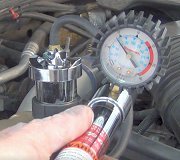Start by stopping on a slight incline, shift to "neutral", release the brakes, then see if the truck creeps downhill on its own. If it doesn't, we'll need to look into dragging brakes.
Due to a house fire, I have to sit in my Ram 1500 and use someone's wireless internet. It has been really cold lately so I run the engine and heater at times. I've gotten as high as 22 mpg average on long trips, but for my daily driving, it stays at around 18 mpg, that is until I let it idle to keep me warm. A few days ago it was down to 13.5 mpg average.
Also keep in mind liquid gasoline doesn't burn. It has to be in vapor form to burn. Years ago we needed a choke for force way too much gas into the engine in hopes a high enough percentage would vaporize in time to burn in the cylinders. The rest went out the tail pipe, wasted. We have the same problem today, but the higher the fuel pressure, the better gas will atomize as it sprays from the injectors. Still, some of it condenses on the cold intake runners and backs of the valves. Fuel mixture is richened in cold weather, still in an attempt to prevent stalling and low power, so fuel mileage will go down.
Injector failures in Chrysler products is just about unheard of, so put those way at the bottom of list of suspects for any running problem.
Along with Chrysler's huge list of innovations that benefitted car owners, one was the lock-up torque converter for better fuel mileage. That goes back to 1977. Yours is electronic, and part of the programming includes that it will not lock up until the coolant reaches a certain temperature. With two of my older Caravans, they'd lock up within a mile of leaving home in the summer. On cold winter days I often got as far as seven miles down my highway before lock-up occurred. If you drive a lot of short trips in cold weather, expect that to cause a huge drop in fuel mileage.
You should also check the diagnostic fault codes as a starting point. Chrysler made doing that yourself much easier than any other manufacturer. Cycle the ignition switch from "off" to "run" three times within five seconds without cranking the engine, leave it in "run", then watch the code numbers appear in the odometer display. You can go here:
https://www.2carpros.com/trouble_codes/obd2/p1200
to see the definitions, or I can interpret them for you. That feature is gone for 2014 models, but I think it still works for 2007 models.
If you have access to a scanner, you can view live data and see the short and long-term fuel trim numbers. Those normally sit around "0". If you see them at high positive, the Engine Computer is requesting more fuel in response to something. We have to figure out what that is. High negative numbers means it's subtracting fuel from the factory-programmed approximate values. The MAP sensor has the biggest say in fuel metering calculations. On older models, a cracked vacuum hose going to it would falsely tell the Engine Computer it was under load and more fuel was needed. Often you'd see black smoke from the tail pipe. Your MAP sensor is plugged into the side of the throttle body assembly, but it would still pay to check it. You can also read intake manifold vacuum with a scanner. That is reported by the MAP sensor. MAP sensor failures aren't real common, but it is something we would look at.
SPONSORED LINKS
Monday, December 28th, 2020 AT 3:24 PM



